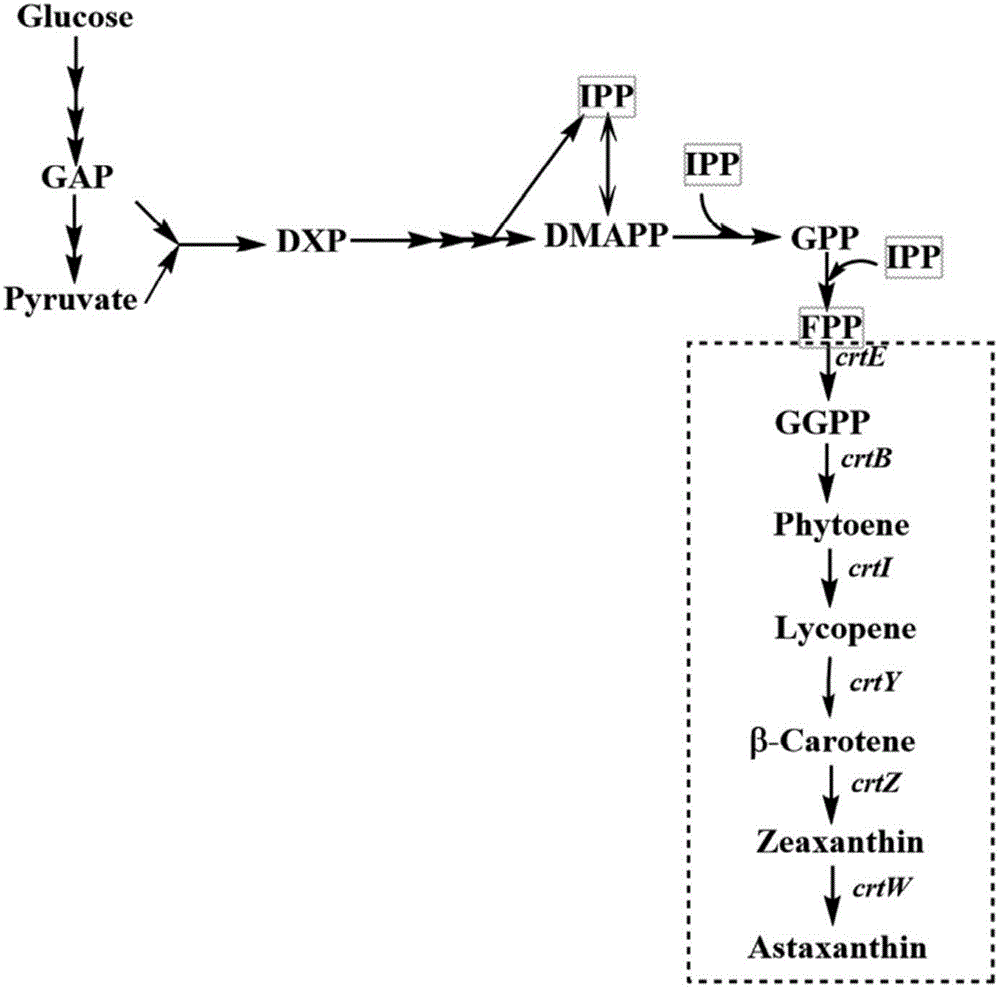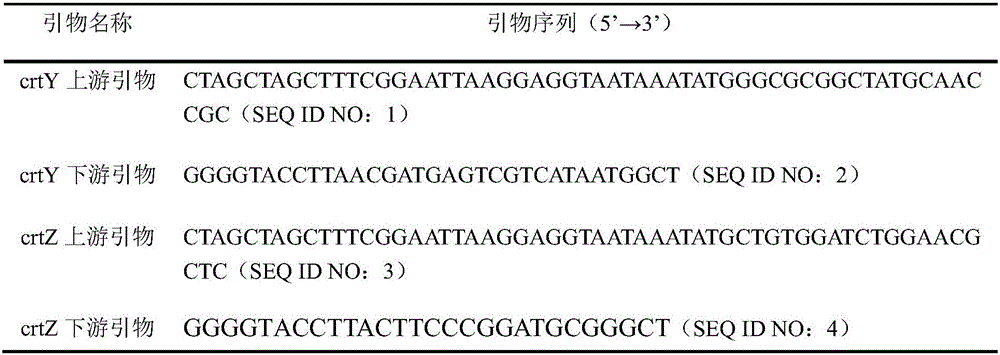Engineering strain capable of producing high-content zeaxanthine or astaxanthin and application thereof
A technology of zeaxanthin and engineering bacteria, which is applied in the field of genetic engineering, can solve the problems of non-specific substrates, difficulty in separation and purification, and limit the preparation of a single type of zeaxanthin or astaxanthin, and achieve the effect of increasing input costs
- Summary
- Abstract
- Description
- Claims
- Application Information
AI Technical Summary
Problems solved by technology
Method used
Image
Examples
Embodiment 1
[0022] Example 1 Using lycopene-producing Escherichia coli as the starting bacterium to construct a plasmid-free engineering bacterium producing high-content zeaxanthin
[0023] Lycopene-producing Escherichia coli itself carries the crtE gene, crtB gene, and crtI gene, and introduces the crtY gene and crtZ gene (genbankD90087) of a specific source and copy number. The steps are as follows:
[0024] (1) Using the Pantoea ananatis genome or the expression plasmid pQE-crtYZ containing the crtY and crtZ genes of Pantoea ananatis as a template, use the primers in Table 1 below to amplify the crtY fragment gene and the crtZ gene fragment respectively.
[0025] Table 1 Amplification primers of crtY gene and crtZ gene
[0026]
[0027] (2) connecting the above-mentioned crtY fragment gene and crtZ gene fragment to the assembly plasmid pZSABP to obtain pZSABP-crtY recombinant plasmid and pZSABP-crtZ recombinant plasmid respectively;
[0028] (3) Digest pZSABP-crtZ with AvrII / SalI, ...
Embodiment 2
[0030] Example 2 Using Escherichia coli producing β-carotene as the starting bacterium to construct a plasmid-free engineering bacterium producing high-content zeaxanthin
[0031] Escherichia coli producing β-carotene itself carries crtE gene, crtB gene, crtI gene, crtY gene, and introduces crtY gene and crtZ gene of specific source and copy number, the steps are as follows:
[0032] (1) The amplification of crtY and crtZ gene fragments, the preparation of pZSABP-crtY recombinant plasmid and pZSABP-crtZ recombinant plasmid are the same as in Example 1;
[0033] (2) digest pZSABP-crtZ with AvrII / SalI, and recover the crtZ fragment; connect it to the XbaI / SalI of pZSABP-crtZ to obtain pZSABP-2*crtZ; use the same method to combine 2*crtZ and the crtY- 2*crtZ were assembled together to obtain pZSABP-crtY-4*crtZ;
[0034] (3) Digest pZSABP-2*crtZ and pZSABP-crtY-4*crtZ with MluI / SalI, recover the gene fragments, connect them to the integration vector pHKKP37b, and obtain the integ...
Embodiment 3
[0035] Example 3 produces high-content astaxanthin-free engineering bacteria
[0036] On the basis of the Escherichia coli ZEAX-4 with high yield of zeaxanthin constructed in Example 1, the crtW gene was introduced, and the steps were as follows:
[0037] (1) In order to improve the expression level of the gene in Escherichia coli, the codons of the gene were optimized according to the codon preference of Escherichia coli. The codon-optimized Brevundimonas crtW gene (see SEQ ID NO: 5 for the nucleotide sequence) was entrusted to Suzhou Jinweizhi Biotechnology Co., Ltd. to synthesize the whole gene, and connected to the pUC57 vector to obtain pUC57-crtW BSP ;
[0038] (2) Digest pUC57-crtW with NheI / PstI BSP, recycle crtW BSP fragment, ligated into the assembly vector pZS5P37 to obtain pZS-5P37-crtW BSP ; Digest pZS-5P37-crtW with BglII / SalI BSP , recycle crtW BSP fragment, ligated into pZS-5P37-crtW BSP Between BamHI / SalI, pZS-2*(5P37-crtW BSP );
[0039] (3) Digest p...
PUM
 Login to View More
Login to View More Abstract
Description
Claims
Application Information
 Login to View More
Login to View More - R&D Engineer
- R&D Manager
- IP Professional
- Industry Leading Data Capabilities
- Powerful AI technology
- Patent DNA Extraction
Browse by: Latest US Patents, China's latest patents, Technical Efficacy Thesaurus, Application Domain, Technology Topic, Popular Technical Reports.
© 2024 PatSnap. All rights reserved.Legal|Privacy policy|Modern Slavery Act Transparency Statement|Sitemap|About US| Contact US: help@patsnap.com










